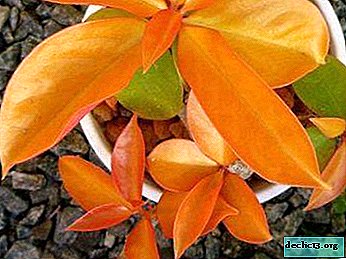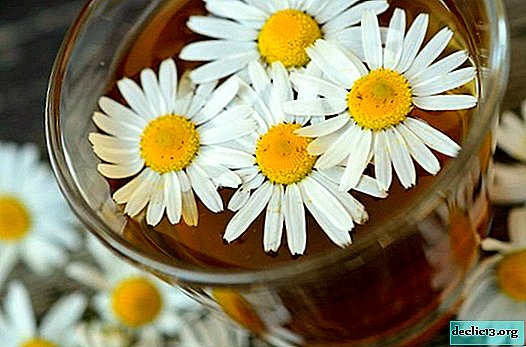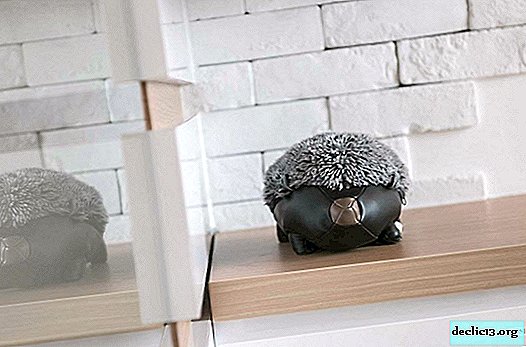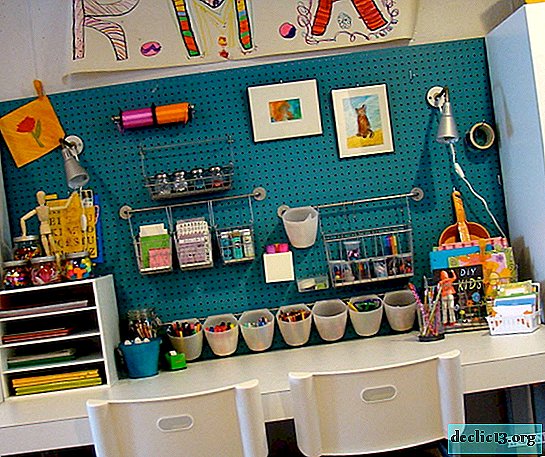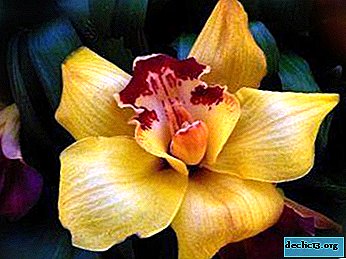Care for flowering Kalanchoe - tips on how to make this plant bloom at home
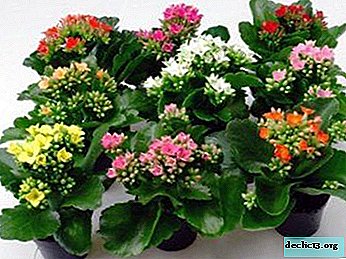
Kalanchoe flower quickly gained great popularity among gardeners, it is with pleasure acquired and grown at home. The plant is exotic, grows very quickly, blooms for quite some time with whole caps of beautiful inflorescences. With its help, you can successfully arrange any boring window sill - to make it rainbow. After all, Kalanchoe has a lot of different shades, both bright and pastel, very delicate. Blue, white, red and orange flowers are not uncommon, and at the end of the last century a variety with purple inflorescences was bred.
Features
There are few plants similar to Kalanchoe in nature, because it is special. On the one hand, this is an excellent “doctor”, some varieties cure a runny nose, sore throat, promote the rapid healing of wounds and cuts, disinfect and regenerate tissues, and are capable of much more. And on the other hand (other varieties) - this is a beautiful elegant flower, which, moreover, is easy to propagate.
Kinds
The most popular and in demand are the following types.
Kalandiva

With wide egg-shaped leaves, beautiful terry flowers of various colors, which bloom for almost six months with a whole armful, hiding almost all foliage under them, leaving only the frame of the bouquet.
Crossfeld

It features bright beautiful flowers that are collected in umbrella inflorescences, the color may be different:
- white
- reds;
- yellow;
- pink;
- orange
- other shades (breeders have achieved such different colors, in nature this species has only white flowers).
Mangina

It is distinguished by small fleshy leaves and large pink flowers in the form of drooping bells, a very effective ampelous plant.
Behar

A fairly powerful plant, it looks very unusual - there are no leaves at the bottom of the stem, but there are a lot of them in the upper part and they are covered with a delicate fluff. Flowers of this species resemble a water lily in shape.
The first two species are most suitable for flower growers - beginners.
Flowering time
After the flowering of Kalanchoe, a period is needed to restore strength, this dormant period usually falls on summer and autumn. Then, in the autumn, flower buds begin to be laid and from the end of winter the plant is transformed - an inflorescence of many flowers is formed. This inflorescence rises above the leaves like a cloud - as if soaring. Flowering time may vary. (depending on type) - from two weeks to three months.
The necessary conditions
No matter how simple the flower is, you still need to take care of it. Read about how to care for Kalanchoe so that it blooms.
Note! Since Kalanchoe is a tropical guest, then the conditions for its proper development and flowering need to be created close to natural.Necessary conditions for flowering:
- bright diffused light;
- proper watering (not abundant);
- fertilizing strictly on schedule (1 time per month);
- obligatory pruning and pinching of the bush (in spring and summer);
- correct temperature conditions (in winter - not lower than 16 degrees, in summer - not higher than 28 degrees).
Why not blooming?
If Kalanchoe does not want to bloom at home, then the rules for its maintenance are violatedthat is, conditions uncomfortable for him were created. The main causes of unwillingness to bloom may be the following:
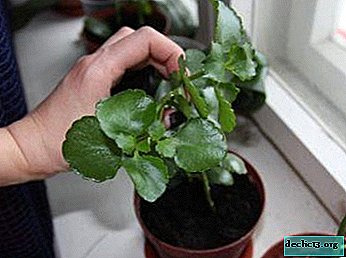 not enough light - the pot stands in a shaded place or on the north window and without any additional lighting;
not enough light - the pot stands in a shaded place or on the north window and without any additional lighting;- improper watering - too intensive is the watering of the plant, because of this, its normal development is disturbed;
- wrong temperature - if you do not withstand temperature standards, for example, the temperature is too low in the winter, then, of course, the plant can simply freeze, not to mention flowering;
- no pruning or pinching - it is very important not to forget to do this, if you leave the bush to grow as he wants, then you can forget about flowering, it will simply grow in height or grow in leaves.
Now you know why Kalanchoe does not bloom.
How to make?
Of course, it’s a shame to look at your wonderful flower, which has blossomed safely after purchase at the store and that’s all, and then it just grows and doesn’t make any hints at the next flowering (how to transplant Kalanchoe after the purchase and properly care for it at home, read here).
Important! Perhaps it is stretched in height or even loses the lower leaves, it becomes like a strange tree with a bare trunk and several small leaves on top (like a palm tree).What to do in this case, if Kalanchoe does not bloom, but only stretches? In order for your indoor plant to bloom, you must take the following steps.
- Urgent need to prune the plant, you can even cardinal, it will save him. Further, of course, to prevent ugly growth up, the process must be controlled.
- Understand - Is Your Pet Getting Enough Light. Most likely, he just does not have enough light, so urgently need to provide some additional source of lighting. Well, if it is a special phytolamp.
- Need to adjust watering. It is possible that the plant suffers from overflow, you can not often water it and prevent stagnation of water in the pan. In winter, you can water it no more than once every 2 weeks (strictly observe this norm).
- Need to check the temperature - After all, flower buds are laid only at low temperatures, and if the apartment has heat during the heating season, they will not be laid. You can move the pot closer to the glass or find a place for it in a cooler room.
Now you know how to make a flowering Kalanchoe bloom.
The Basics of Proper Care
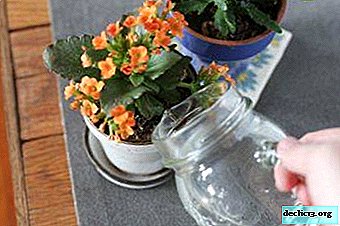 Lighting - Light for flowering plants plays an important role (almost the main one), so a lot of light is required. The best place, of course, is on the windowsill (but not in the north).
Lighting - Light for flowering plants plays an important role (almost the main one), so a lot of light is required. The best place, of course, is on the windowsill (but not in the north).Kalanchoe can withstand direct sunlight, but not all day, if the pot is on the south window, then after lunch it should be shaded (with a light curtain), and the most optimal placement option is the east-facing window. If in winter there is not enough light on cloudy days, then you have to additionally highlight (preferably with a phytolamp).
- Watering - since Kalanchoe is a succulent and has an excellent ability to accumulate moisture in its leaves and trunk, watering for it should be moderate, in the winter it is enough to water it once every two weeks, in the summer more often - about once a week, you need to navigate as soil in the pot and depending on air temperature.
- Top dressing - it should be applied very carefully, in small doses and only special ones (it is best to buy a balanced one for succulents), even this special fertilizer should be diluted with water (in half). Feeding is rarely necessary - once a month and only in the spring-summer season. It is impossible to overfeed Kalanchoe, otherwise it may not bloom, but will simply begin to “fatten”.
- Humidity - the plant is undemanding to moist air, calmly transfers dry air indoors, it is not necessary to spray it. It is only necessary to periodically wipe the leaves from dust (preferably with a damp cloth) so that the air exchange is not disturbed.
- Temperature - the required temperature in the summer is about 28 - 30 degrees, and in winter you need a cooler - 14 - 16 degrees, you can’t get colder, otherwise the flower buds may suffer.
- Pruning - This is a very important condition for flowering, if you do not pinch and prune, do not form a bush, then you can not wait for flowering soon.
Tip. You need to prune Kalanchoe in the spring - all elongated shoots are shortened by about 1/3 or even cut in half, at the beginning of summer you also need to pay attention to this process - pinch or trim all young shoots, after flowering, you also need to make a pinch.
After performing all these manipulations, you can be sure that Kalanchoe will bloom beautifully in the near future.
The intricacies of caring for Kalanchoe at home during and after flowering can be found in our material.
Video on the topic "Indoor Kalanchoe flowering. How to achieve flowering at Kalanchoe? ":
Conclusion
The conclusion can be drawn as follows - if you want to enjoy a pleasant cozy atmosphere, which is created by flowering plants to a large extent, then first create a pleasant atmosphere for these plants. At least a minimum of attention deserves every flower, whether it is exotic or very simple.
After all, everyone gets used to their native habitat, and getting into our apartments, of course, is forced to adapt somehow. To make this more painless, you need to try to provide the plant with everything necessary for its comfort.

 not enough light - the pot stands in a shaded place or on the north window and without any additional lighting;
not enough light - the pot stands in a shaded place or on the north window and without any additional lighting; Lighting - Light for flowering plants plays an important role (almost the main one), so a lot of light is required. The best place, of course, is on the windowsill (but not in the north).
Lighting - Light for flowering plants plays an important role (almost the main one), so a lot of light is required. The best place, of course, is on the windowsill (but not in the north).

